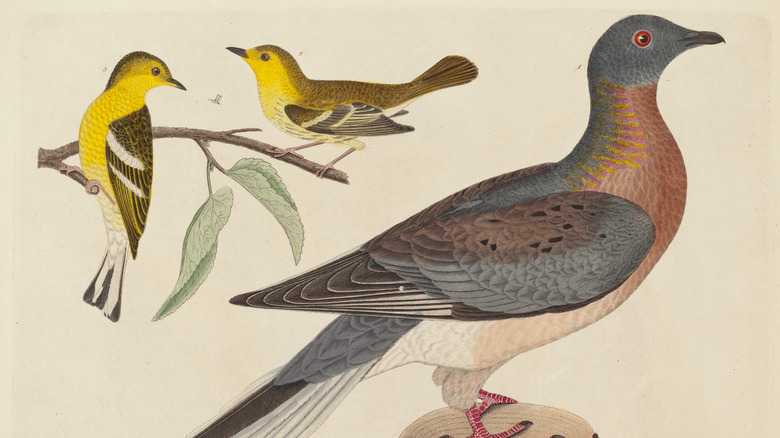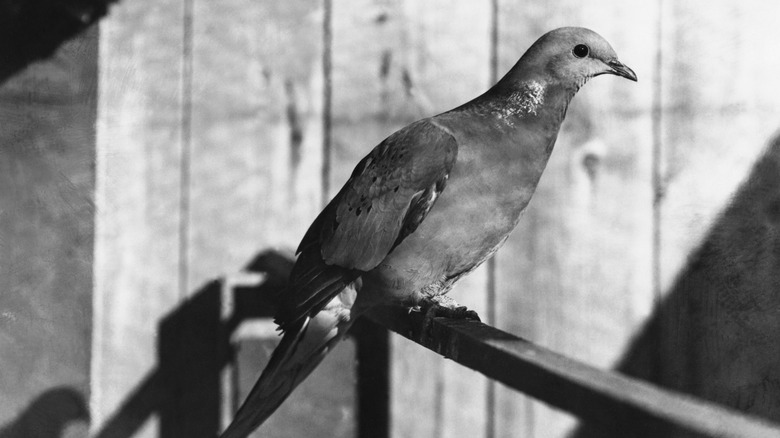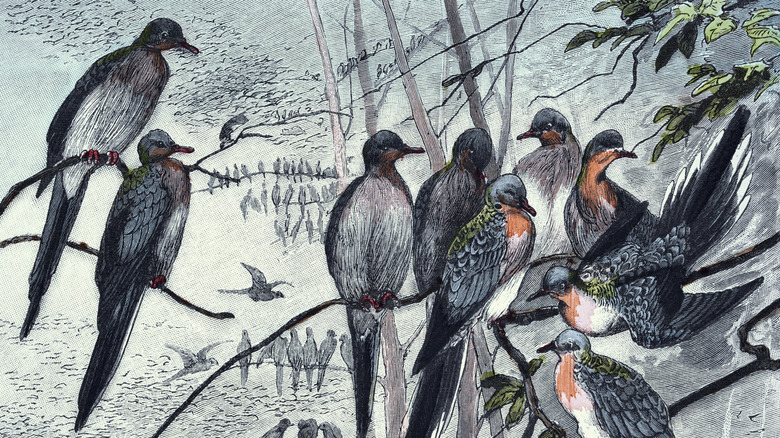The Tragic Reason Why The Passenger Pigeon Went Extinct
Despite their reputation for being dirty and disease-carrying, pigeons are actually quite clean animals that pose little risk of transmitting pathogens to humans. Pigeons aren't stupid, either, despite their nests looking so horrible. And many of the world's 300 pigeon species are absolutely gorgeous to look at. Few, however, rival the beauty of the red-breasted passenger pigeon (Ectopistes migratorius), a bird that once took to the skies of North America in the billions before humans drove it extinct in the early 20th century.
Passenger pigeons were so numerous that, at one point, they accounted for anywhere between 25% and 40% of the North American bird population, according to accounts from the 20th-century conservationist A.W. Shorger. At the time of Europeans' arrival in the Americas, it's said that their population sat at anywhere between 3 and 5 billion individual members. Their colossal flocks would number in the millions and take hours to pass, blocking out vast portions of the sky and breaking the branches of the trees they roosted in. The birds were highly mobile, not only migrating with the seasons but moving from region to region in search of the best food and migratory sites. In 1871, one such roost in Wisconsin reportedly covered 850 acres and housed over 130,000,000 birds.
But on September 1, 1914, the last of the passenger pigeon's kind — a 29-year-old bird named Martha — died in captivity at the Cincinnati Zoological Garden. So, what happened? How did a species that numbered in the billions just a few decades earlier come to meet its end? The story of their downfall is devastating, but it serves as a powerful reminder of humanity's role in the world's natural ecosystems.
A perfect storm of human impact
The rapid extinction of the passenger pigeon wasn't due to a single cause, but a potent combination of human pressures that, much like what caused dodos to go extinct, the species simply couldn't withstand. As early European settlers in the eastern part of the United States and Canada (the bird's primary range) began to clear forests for farmland, the pigeons took to the farmers' fields to find food. Their sheer group size meant they caused significant damage to these crops, prompting farmers to retaliate by hunting them for their meat. But the real blow to their numbers started sometime in the 1800s when commercial hunters began seeking out the birds to sell in urban markets.
Without any legal protection, passenger pigeon numbers fell drastically, with their tendency to move in large groups working to their disadvantage. The mass killing was so intense that, at one nesting site in Michigan in 1878, 50,000 pigeons were being killed every single day. What state-level laws were passed were weakly enforced (if at all), and the slaughter continued more or less unabated. Print publications encouraged hunters and kept them attuned to the pigeons' movements, as seen in an 1857 edition of the Marshall County Republican, a newspaper from Plymouth, Indiana: "Wild pigeons are becoming very plentiful hereabouts. Shoot them or they will prey upon your wheatfields. They don't make a bad old fashioned pot pie."
Because the passenger pigeon needed large tracts of forest to sustain its numbers, groups fragmented. Their own biology and instincts worked against them. The bird bred communally in large colonies, and their reproductive behavior broke down in smaller groups — a foreboding sign for future attempts to revive the species, which failed for the very same reason.
How passenger pigeons inspired a movement
The 1914 death of Martha, the last known passenger pigeon, marked the end of a species that had once dominated North America's skies. Gone was an ecological force that had etched itself into the continent's history books and cultural memory. Passenger pigeons had once played a role in forest regeneration, acting as seed dispersers and even changing a forest's soil chemistry due to their large numbers. Their absence left a quiet vacuum in eastern forests that no other species has quite filled.
More than this, passenger pigeons represented the human belief that, no matter what we did, the bounty of nature was endless. The stark realization that this was not the case contributed directly to the rise of early wildlife protection laws, like the Lacey Act, the Weeks-McLean Act, and the Migratory Bird Treaty Act of 1918. The story of the pigeon has likewise influenced the many successful efforts to keep other American species from going extinct, like the American bison, the blue crab, and the black-footed ferret. It also allows us to ponder important questions for species around the planet, like what would happen if the Tasmanian tiger never went extinct.
Today, specimens of passenger pigeons are studied in museums, their DNA preserved in hopes of reviving them. Organizations like Revive & Restore are even exploring de-extinction options, using CRISPR gene-editing technology in the effort to bring the bird (or a at least a proxy species) back from extinction. But even if that day never comes, the passenger pigeon remains an enduring lesson and a warning about the speed at which human activity can unravel nature, as well as the responsibility we have to protect what remains.


